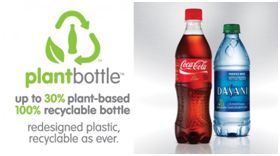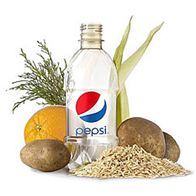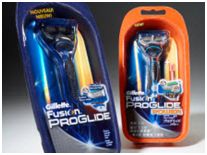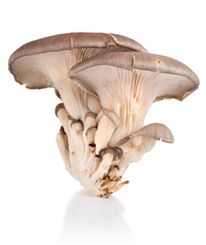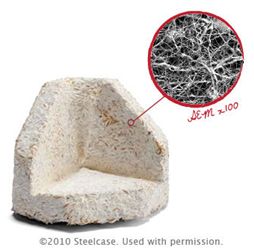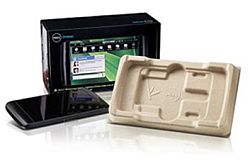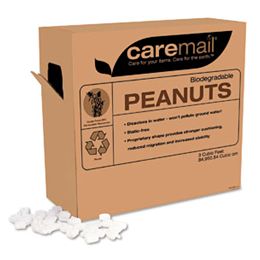![]()
You are welcome to share your thoughts on this article written by Cheryl Swanson, Founding principal at Toniq llc, NYC
Life Beyond Plastic?
Nature gives us so much yet we still abuse, waste and ignore the amazing materials they provide us. There’s a sick affinity for chemicals and plastics in the packaging world. If we look at the cost of packaging goods in plastic, in the long run, the cost skyrockets past the use of natural, sustainable resources in exchange. And let’s not forget the crunchy, granola aspect of saving the world for the common good.
In the US, 30 million tons of plastic waste was generated in 2009 and only 7 percent of the total plastic waste was recovered for recycling (according to the EPA). So where does the rest end up? Land fills, the ocean — like the Great Pacific Garbage Patch, littered in parks and streets, and burned to create smog and a larger hole in the ozone. Did you know it takes 1000 years for a plastic bag to breakdown in a landfill?
So is there life beyond plastic?
Yes! This is where “ethical consumerism” and “green and sustainability” trends are driving innovation. These trends are driving consumer goods companies to be more innovative when it comes to packaging. We live in a culture of mass consumption and packaging matters.
There are the companies that pride themselves on being green and those are the companies where we expect to see sustainable packages. For example, Seventh Generation and their new cardboard detergent jugs, Whole Foods not offering plastic bags, Burt’s Bees using recycled plastic for the lip balm, and so on.
But, more recently and exciting is seeing the big companies take responsibility and addressing this global waste issue. Coca-Cola introduced their version of the greener bottle, aptly named PlantBottle. 30% of the bottle is plant based. Coke’s not 100% yet, but it’s a step in the right direction. And soon after Coke’s big announcement, we saw Pepsi roll out bottles made entirely, 100%, from vegetable matter. Pepsi’s goal is to use orange peels, oat hulls, potato scraps and other leftovers from its food business. Procter & Gamble, released a new Gillette Fusion ProGlide Power Razor in environmentally sustainable packaging produced by Be Green Packaging. This new razor package reduces plastics by 79% while maintaining the products look and feel. And hopefully, this is just the beginning.
There are so many unique materials that just aren’t being utilized in the consumer product world. Here are few amazing new materials that we have seen in our research:
Ecocradle: This is an amazing product grown from mushrooms. Mycelium, a fungal network of threadlike cells, grows around agricultural by-products like buckwheat husks, oat hulls, or cotton burrs to any shape. In 5 — 7 days, in the dark, with no watering, and no petrochemical inputs, the mycelium envelops the by-products, binding them into a strong and beautiful packaging part. Ecocradle non-disruptive to the environment, non-toxic to humans, and creates a product that is 100 percent natural that can easily be returned to the Earth.
Bamboo: Bamboo is one of the fastest growing (it can grow up to 24” a day), most renewable resources in the world. We’ve seen more use of bamboo in the western world over the recent year from packaging to clothing. In clothing, bamboo fibers naturally wick moisture and is antibacterial. In packaging, it is a strong building material as well as a composite that can be formed and recycled. What brand is making this top news? Dell. Two-thirds of all Dell products ship in bamboo made packages. Goodbye Styrofoam, hello bamboo! Dell is also exploring the mushroom package as well. A big thumbs up for Dell!
Cornstarch Peanuts: I’m sure you’ve experienced the mess of those pesky Styrofoam peanuts that burst out of boxes when you open them. They stick to everything and have an alarming, un-natural look and toxic smell to them. Finally, there’s a solution to this, cornstarch made packing peanuts. Corn is literally ground and made into pellets that are then made into packing peanuts. They are 100% biodegradable. They dissolve safely in water or can be thrown into the compost bin. There’s a trend for cornstarch peanut art as well. Search “cornstarch peanut art”, it’s amazing what people do with these things.
As the old saying goes, the squeaky wheel gets the oil! The more we take a stand, start the trend, or turn up the volume on the trends we follow, the more we can drive innovation. As consumers, our soapbox and purchasing power is bigger than ever and the companies have to listen to stay on top.
We would love to hear what you think about these packaging innovations. Visit us on our website at www.toniq.com or tweet us @brandeffervesce. We look forward to hearing from you!
About the Author
Ms. Swanson founded Toniq in 1999 after leading several design firms to world-class status with her emotions-based, visual approach to brand strategy development. At Toniq, she continues to evolve her strategic expertise by seeking new ways to connect with consumers.
Swanson’s years of trend tracking, design management and research have coalesced in a theory of “Brand Effervescence ™” an innovative approach to brand building. This image-based approach is a synthesis of cultural anthropology, consumer trends research, marketing and design, and a study of the psychology of symbolism and color.
